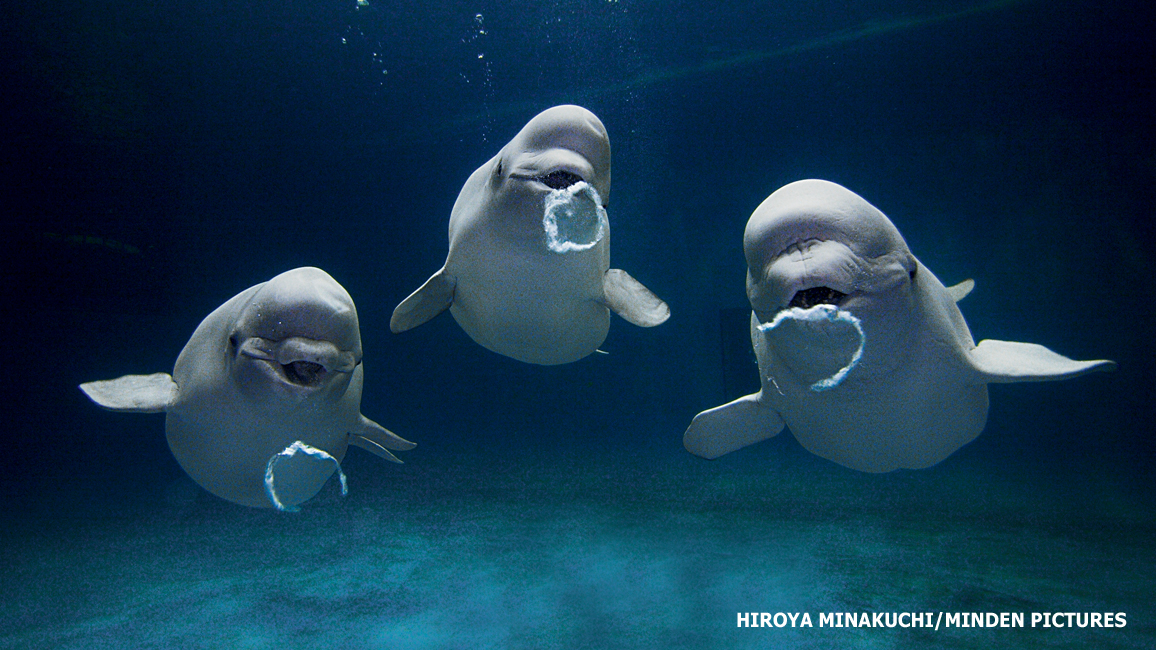
Belugas
By Kathy KrankingDive in to meet these chatty white whales.

From clicks to whistles to chirps to squeaks, a beluga whale (above) sure has a lot to say. Belugas talk to each other constantly, and they can make more than 25 different sounds!
In the icy Arctic waters where belugas live (see map), the days are dark for half of the year. So, sound is an important way for the whales to keep in touch. They also use sound to find their way around, hunt prey, and avoid predators. When people first heard the belugas’ chirps, whistles, and other noises, they gave them the nickname “canaries of the sea”!

MELON HEAD
A beluga doesn’t make sounds the way you do. Instead of a “voice box” in its throat, it uses air-filled sacs inside its head. The whale can aim the sounds by pointing its melon in the direction it wants the sound to travel. Its melon is the big, bulging part of a beluga’s forehead. And to make different sounds, the beluga changes the melon’s shape.
A beluga also uses its melon for echolocation (eh-koh-loh-KAY-shun). This happens when the beluga makes a series of clicks that travel as sound waves through the water. When the sound waves hit an object, they bounce back as echoes to the beluga. By listening to the echoes, the whale can tell the size and shape of the object and even how far away it is. It’s like “seeing” with sound. A beluga uses echolocation to help it find its way around and hunt for fishes, crabs, and other prey.
BUILT FOR COLD
A beluga is built to survive in its icy world. Under its skin, it has a thick layer of fat called blubber. Blubber is like a built-in blanket that keeps the beluga warm. Also, the beluga’s white coloring helps it blend in with ice chunks. That can make it harder for its main enemies, polar bears and orcas, to see it. And a beluga has no fin on its back. Instead, it has just a low ridge. With no fin to get in the way, the whale can glide easily under sheets of floating ice.
Unlike other whales, a beluga has a very bendable neck. That means belugas are able to turn their heads from side to side—and even nod! This gives the whales more flexibility when swimming or catching food.

BABY BOOM
Belugas seem to enjoy each other’s company. They hang out in groups called pods, each of which can have just a few members or hundreds! The whales don’t always stay in the same pod, though. Sometimes they’ll join other groups.
During the spring and summer, the sea ice melts and the pods usually move to areas where the water is a little warmer to have their young.
A beluga mom gives birth to a single calf at a time. Her newborn calf is able to swim along with her right away. When calves are born, their skin is gray. It can take five or more years for their coloring to change to icy white. A baby beluga may stay with its mom for three years or more.
SPA VISIT
During the winter months, a beluga’s skin may start to thicken and look yellowish. So by summer, it’s time for a “beauty treatment.” That’s when belugas gather in areas called estuaries (ES-chuh-wair-eez), which are places along the coast where fresh water from rivers mixes with salty sea waters.
The water in those estuaries is shallow and the bottom is gravelly. It’s a perfect place for the whales to rub themselves against the stones, scrubbing off layers of old, dead skin. This also can help rub off tiny pesky creatures. It probably feels good, too!
TOO MUCH RACKET
For a chatty animal like a beluga, being able to hear what other whales are saying is super important. They depend on sound for their survival.
Sadly, in some places where belugas live, there is a lot of underwater noise. The sounds come from ships, underwater construction, and other human causes. They make it hard for the whales to hear each other and find food. But people are working on ways to limit these sounds. They hope to keep the belugas talking—and listening—forever!
















